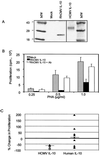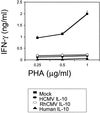Potent immunosuppressive activities of cytomegalovirus-encoded interleukin-10
- PMID: 11773404
- PMCID: PMC135865
- DOI: 10.1128/jvi.76.3.1285-1292.2002
Potent immunosuppressive activities of cytomegalovirus-encoded interleukin-10
Erratum in
- J Virol 2002 Apr;76(7):3585
Abstract
Cytomegalovirus (CMV) has highly evolved mechanisms for avoiding detection by the host immune system. Recently, in the genomes of human and primate CMV, a novel gene comprising segments of noncontiguous open reading frames was identified and found to have limited predicted homology to endogenous cellular interleukin-10 (IL-10). Here we investigate the biological activities of the CMV IL-10-like gene product and show it to possess potent immunosuppressive properties. Both purified bacterium-derived recombinant CMV IL-10 and CMV IL-10 expressed in supernatants of human cells were found to inhibit proliferation of mitogen-stimulated peripheral blood mononuclear cells (PBMCs), with specific activity comparable to that of recombinant human IL-10. In addition, CMV IL-10 expressed from human cells inhibited cytokine synthesis, as treatment of stimulated PBMCs and monocytes with CMV IL-10 led to a marked decrease in production of proinflammatory cytokines. Finally, CMV IL-10 was observed to decrease cell surface expression of both major histocompatibility complex (MHC) class I and class II molecules, while conversely increasing expression of the nonclassical MHC allele HLA-G. These results demonstrate for the first time that CMV has a biologically active IL-10 homolog that may contribute to immune evasion during virus infection.
Figures





Similar articles
-
CXCL10 production from cytomegalovirus-stimulated microglia is regulated by both human and viral interleukin-10.J Virol. 2003 Apr;77(8):4502-15. doi: 10.1128/jvi.77.8.4502-4515.2003. J Virol. 2003. PMID: 12663757 Free PMC article.
-
Fatal attraction: cytomegalovirus-encoded chemokine homologs.Curr Top Microbiol Immunol. 2002;269:235-56. doi: 10.1007/978-3-642-59421-2_14. Curr Top Microbiol Immunol. 2002. PMID: 12224512
-
Cytomegalovirus immediate early genes upregulate interleukin-6 gene expression.J Investig Med. 1997 Apr;45(4):175-82. J Investig Med. 1997. PMID: 9154298
-
Role of tumor cell immune escape mechanisms in cytomegalovirus-mediated oncomodulation.Med Res Rev. 2005 Mar;25(2):167-85. doi: 10.1002/med.20018. Med Res Rev. 2005. PMID: 15389728 Review.
-
The family of IL-10-related cytokines and their receptors: related, but to what extent?Cytokine Growth Factor Rev. 2002 Jun;13(3):223-40. doi: 10.1016/s1359-6101(02)00012-6. Cytokine Growth Factor Rev. 2002. PMID: 12486876 Review.
Cited by
-
Viral manipulation of the host immune response.Curr Opin Immunol. 2015 Oct;36:54-60. doi: 10.1016/j.coi.2015.06.012. Epub 2015 Jul 10. Curr Opin Immunol. 2015. PMID: 26177523 Free PMC article. Review.
-
Cytomegalovirus infection in pediatric rheumatic diseases: a review.Pediatr Rheumatol Online J. 2010 May 20;8:17. doi: 10.1186/1546-0096-8-17. Pediatr Rheumatol Online J. 2010. PMID: 20487534 Free PMC article.
-
The MHV68 M2 protein drives IL-10 dependent B cell proliferation and differentiation.PLoS Pathog. 2008 Apr 4;4(4):e1000039. doi: 10.1371/journal.ppat.1000039. PLoS Pathog. 2008. PMID: 18389062 Free PMC article.
-
The MHC class II antigen presentation pathway in human monocytes differs by subset and is regulated by cytokines.PLoS One. 2017 Aug 23;12(8):e0183594. doi: 10.1371/journal.pone.0183594. eCollection 2017. PLoS One. 2017. PMID: 28832681 Free PMC article.
-
Recent Approaches and Strategies in the Generation of Anti-human Cytomegalovirus Vaccines.Methods Mol Biol. 2021;2244:403-463. doi: 10.1007/978-1-0716-1111-1_19. Methods Mol Biol. 2021. PMID: 33555597
References
-
- Beck, S., and B. G. Barrel. 1988. Human cytomegalovirus encodes a glycoprotein homologous to MHC class-I antigens. Nature 331:269–272. - PubMed
-
- Chee, M. S., A. T. Bankier, S. Beck, R. Bohni, C. M. Brown, R. Cerny, T. Horsnell, C. A. Hutchison, T. Kouzarides, J. A. Martignetti, et al. 1990. Analysis of the protein-coding content of the sequence of human cytomegalovirus strain AD169. Curr. Top. Microbiol. Immunol. 154:125–169. - PubMed
-
- de Waal Malefyt, R., J. Haanen, H. Spits, M. G. Roncarolo, A. te Velde, C. Figdor, K. Johnson, R. Kastelein, H. Yssel, and J. E. de Vries. 1991. Interleukin 10 (IL-10) and viral IL-10 strongly reduce antigen-specific human T cell proliferation by diminishing the antigen-presenting capacity of monocytes via downregulation of class II major histocompatibility complex expression. J. Exp. Med. 174:915–924. - PMC - PubMed
Publication types
MeSH terms
Substances
Grants and funding
LinkOut - more resources
Full Text Sources
Other Literature Sources
Research Materials

